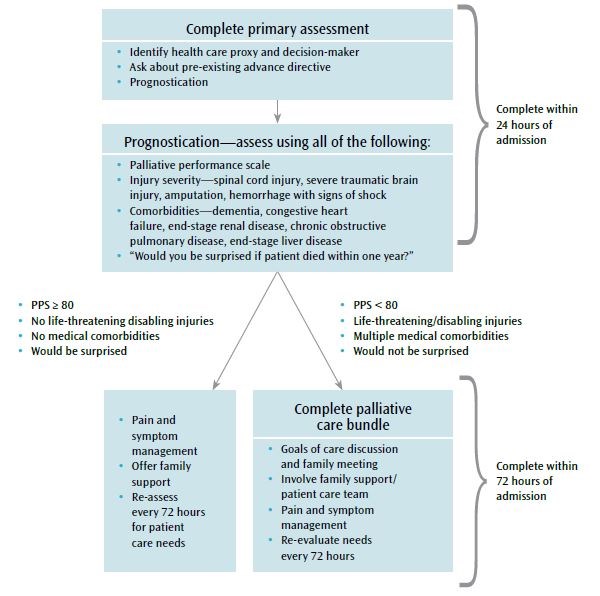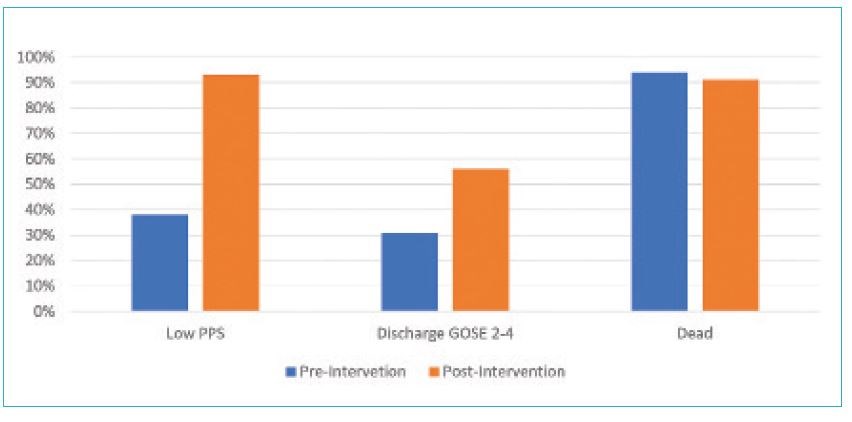The American College of Surgeons (ACS) Trauma Quality Improvement Program (TQIP) Palliative Care Best Practice Guidelines recommend that all trauma patients be evaluated for palliative care needs within 24 hours of admission. Patients identified as having life-threatening or disabling traumatic injuries or those with less severe injuries but who are frail or have multiple comorbidities should have a goals of care conversation within 72 hours of admission.12 We used these guidelines to create and monitor our quality improvement (QI) initiative.
To increase goals of care conversations in patients with a high likelihood of being discharged with a poor functional outcome (GOSE of 2–4), we targeted patients with low PPS (< 80) scores. This target was based on the findings from the prospective study performed by Hwang and colleagues.11
Before initiating the QI project, it was imperative that we obtain buy-in. With support of the trauma medical director and chair of the surgical department, we engaged key stakeholders, including the head of QI and the trauma nurse manager. In addition, we performed an assessment with the advance practice providers to discuss the barriers they faced. After engaging all these individuals, we presented our data on goals of care conversations and our plan for our project to all members of the trauma team during both a trauma section meeting and trauma grand rounds. In addition, flyers were placed in the surgical intensive care unit (ICU).
Carrying out the QI activity
This QI project was implemented April 9, 2019. The purpose of the project was to increase goals of care conversations in older patients with a low pre-injury PPS score by using a score of less than 80 as a trigger for the conversation.
Our revised standard practice consisted of all admitted trauma patients 55 years and older who had a PPS calculated on admission. A score of less than 80 was an automatic trigger for referral for a goals of care conversation to occur within 72 hours. The resident physician or advance practice provider evaluating the patient would initiate the discussion or call a palliative care consult if they felt the patient had advanced needs they could not manage. Goals of care conversations and palliative care consult for all other patients remained at the discretion of the attending based on degree of injury severity and preexisting comorbidities. A flow chart for patient evaluation is depicted in Figure 1.
Prior to implementation of this QI project, all members of the trauma team, including attendings and advance practice providers, had been trained in evaluating the PPS and in engaging in goals of care conversations. A palliative care specialist was brought in to host a one-day workshop on communication skills that included didactics and role play. Following this workshop, advance practice providers were equipped with the tools not only to evaluate PPS but also to hold goals of care conversations independently.
No additional staff was required for the implementation of this project. Buy-in and participation were necessary from the trauma team, including the trauma medical director, trauma faculty, advance practice providers, and residents. In addition, support from the palliative care team was needed. This project was led by a surgical research fellow working in the trauma department. There were no additional costs to implement this project, and no funding sources were directly related to this project. The surgical research fellow received salary support from the Auen Foundation for research in palliative care.
Results
Over a six-month period, 147 of 172 (85 percent) admitted trauma patients age 55 years and older had a PPS documented, with 43 percent completed within 24 hours of admission. Goals of care conversations took place with 93 percent of patients with a low pre-injury PPS, which was a 55 percent increase from pre-intervention. By increasing goals of care conversations in patients with low PPS, we also were able to increase conversations among patients discharged with poor functional outcomes by 25 percent (see Figure 2). Nearly two-thirds (64 percent) of all goals of care conversations occurred within 72 hours of admission. Of patients who had a goals of care conversation, 14 percent met independently with advance practice providers. The remainder of the conversations took place with the palliative care team or surgical attendings.
FIGURE 2. PROPORTION OF GOALS OF CARE CONVERSATION: PRE- AND POST-IMPLEMENTATION OF PPS AS TRIGGER IN PATIENTS WITH LOW PPS, POOR FUNCTIONAL OUTCOME AT DISCHARGE, AND INHOSPITAL MORTALITY


